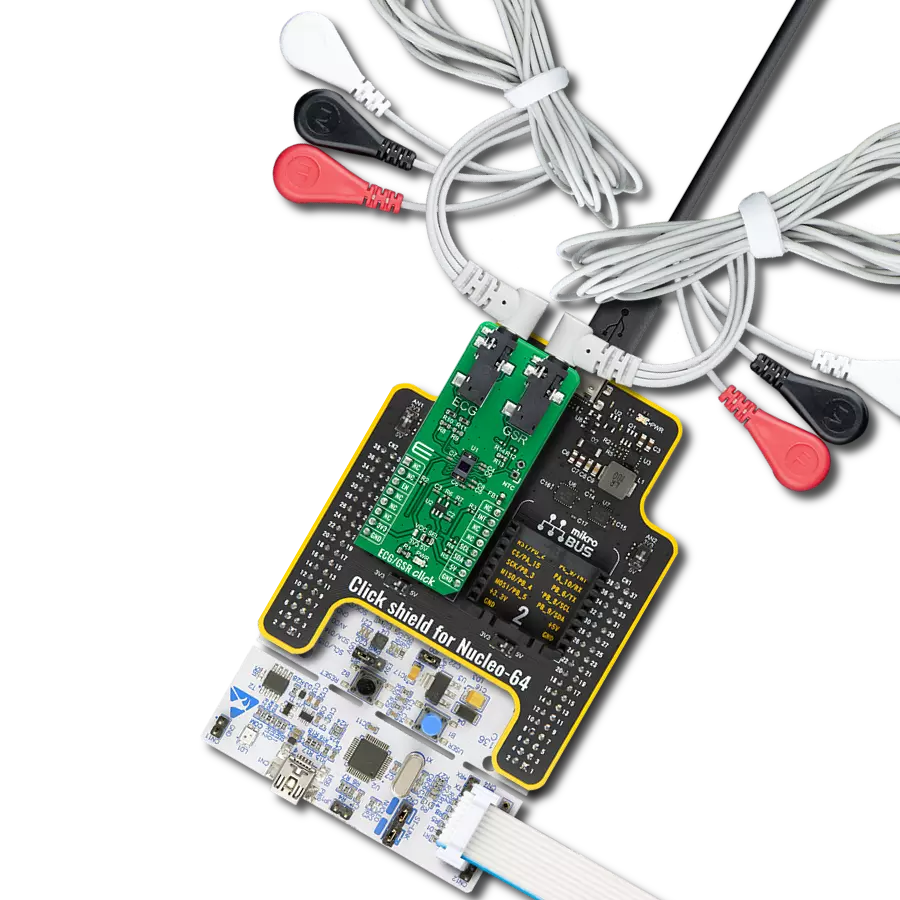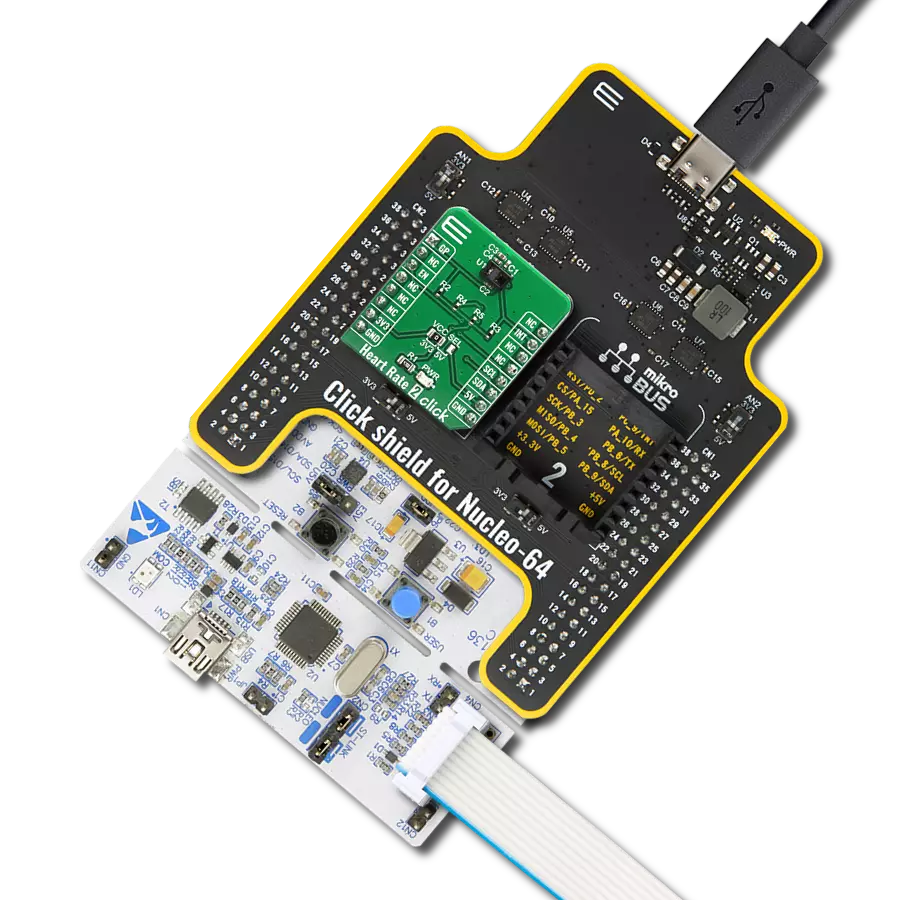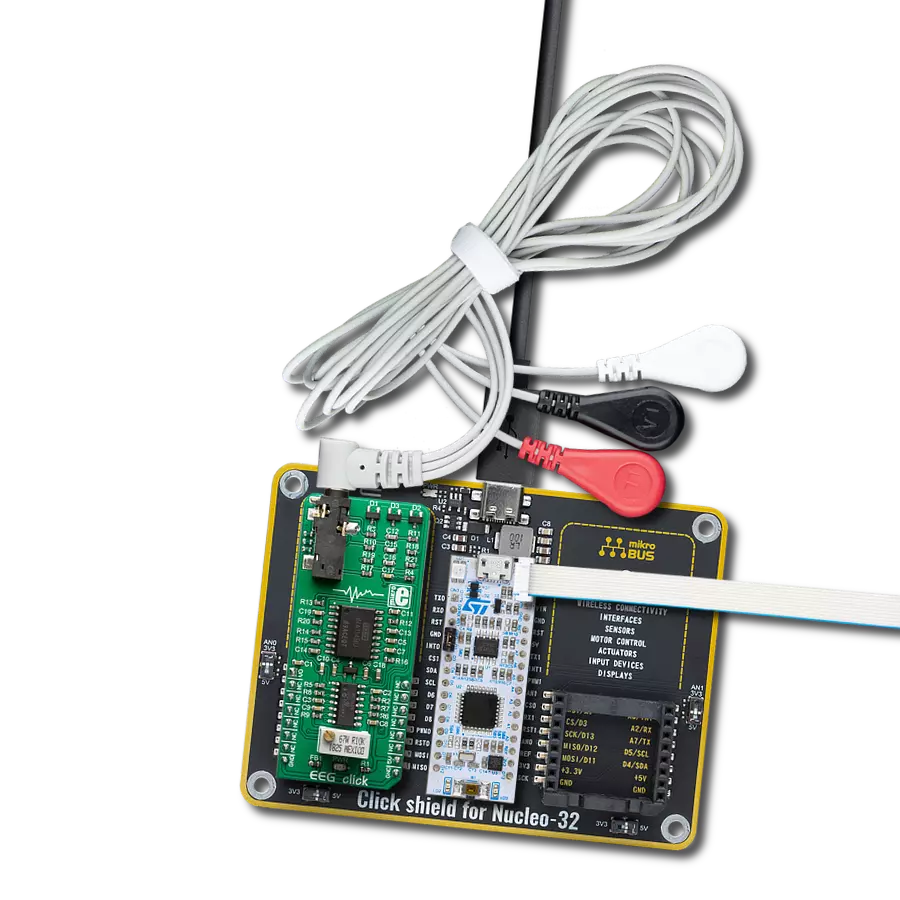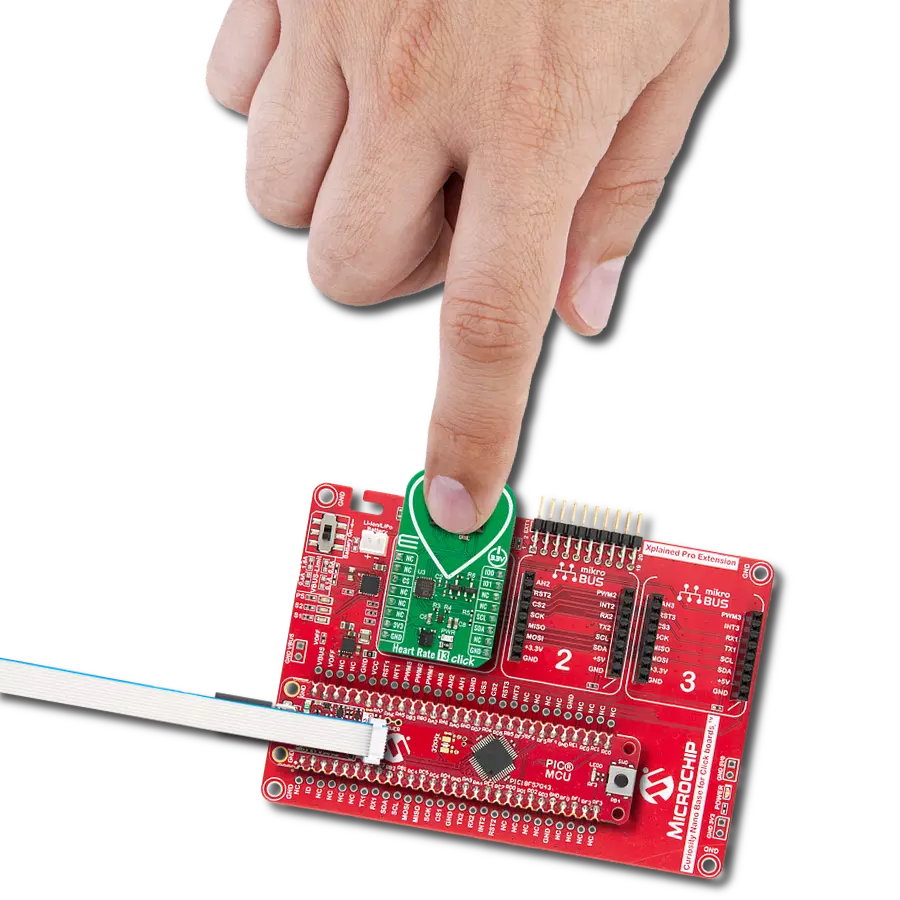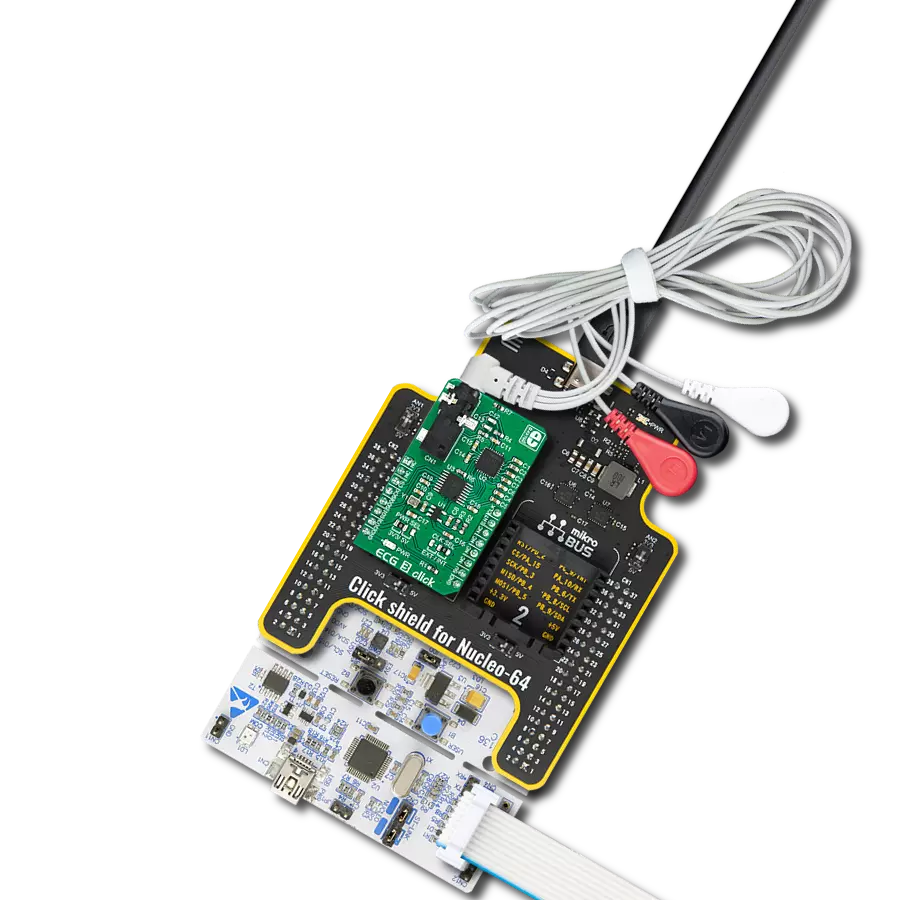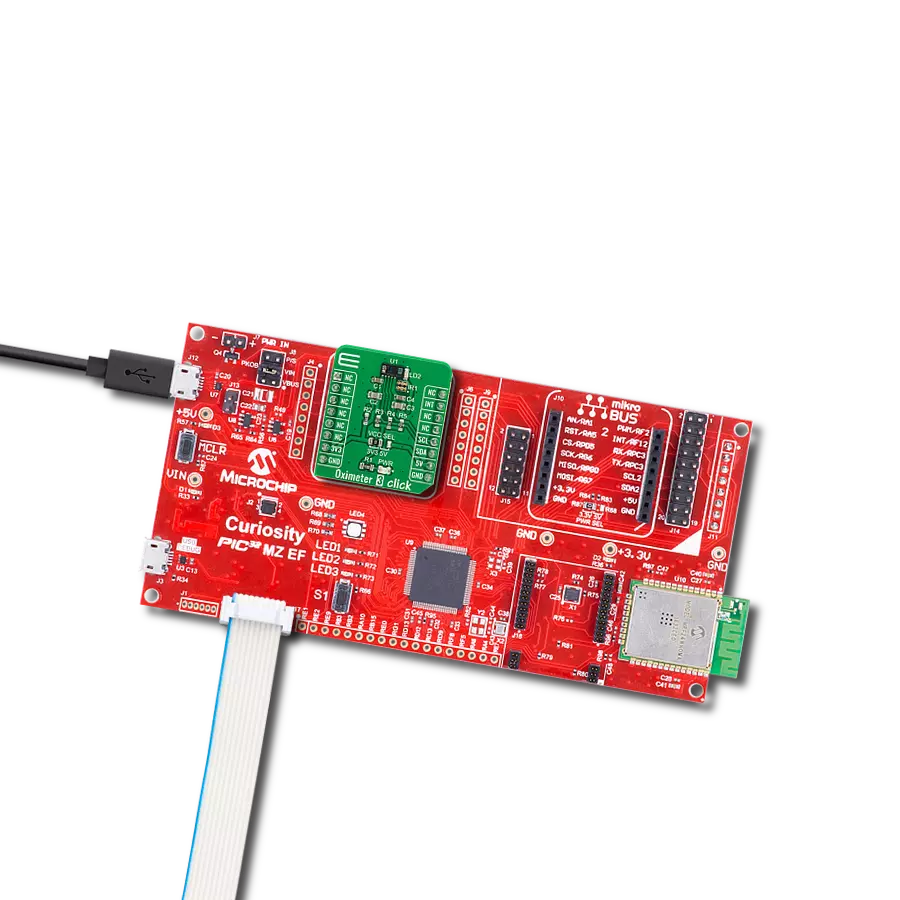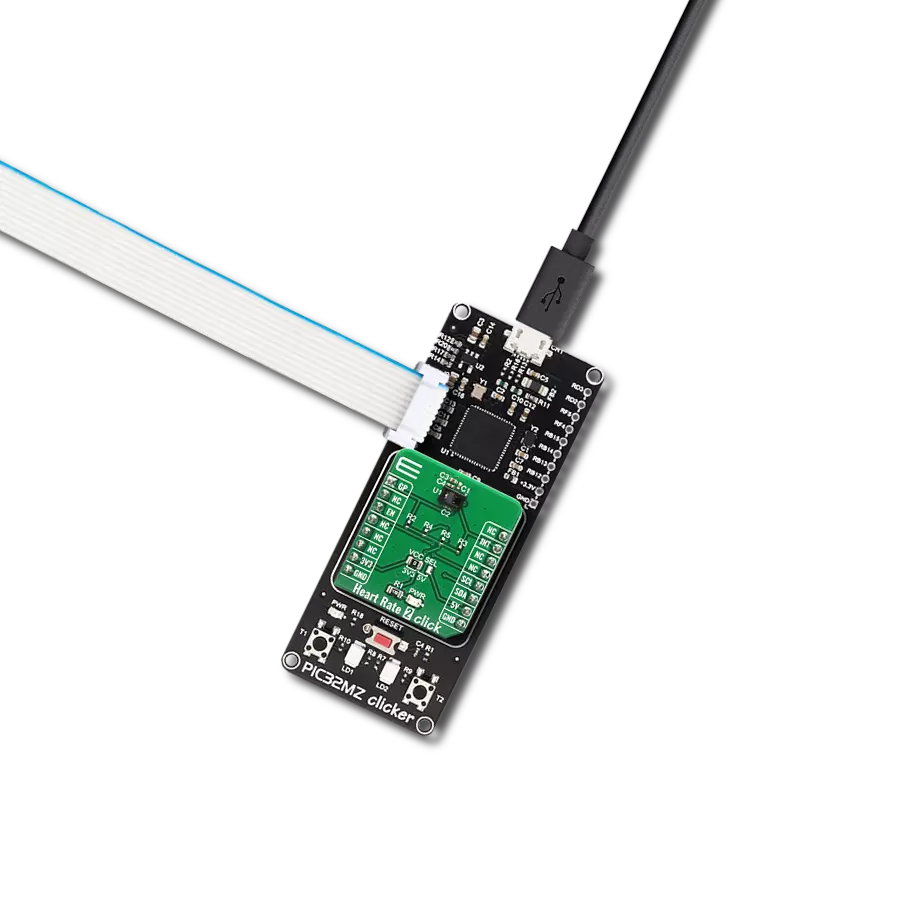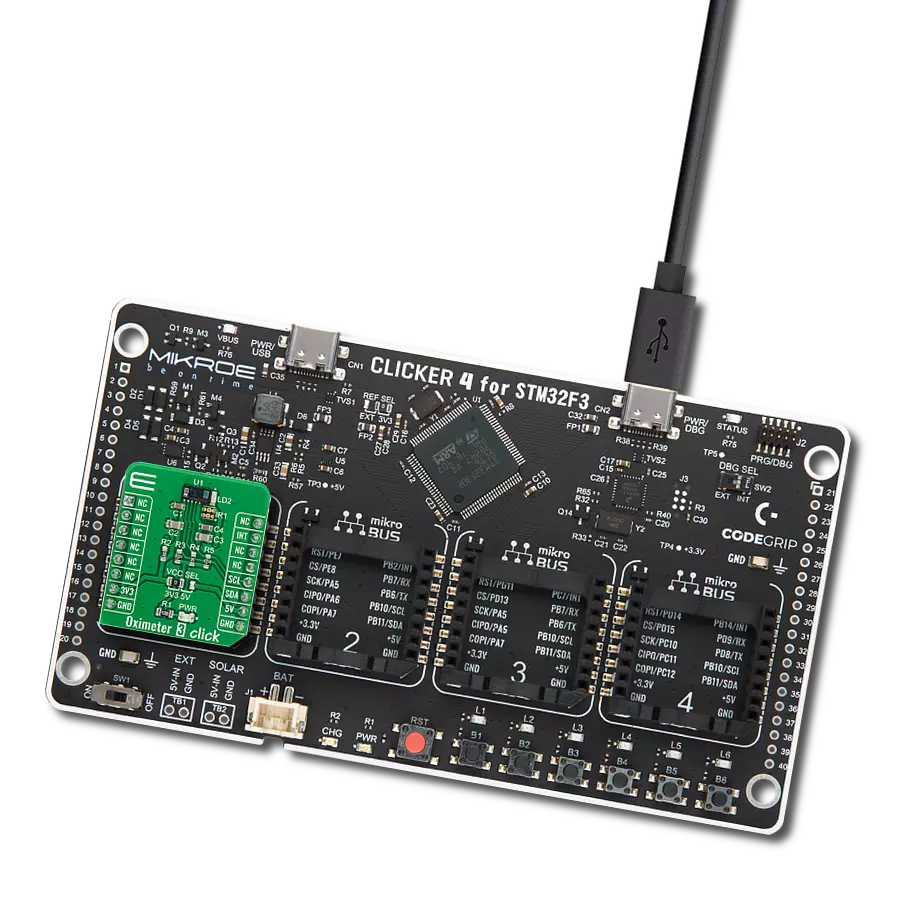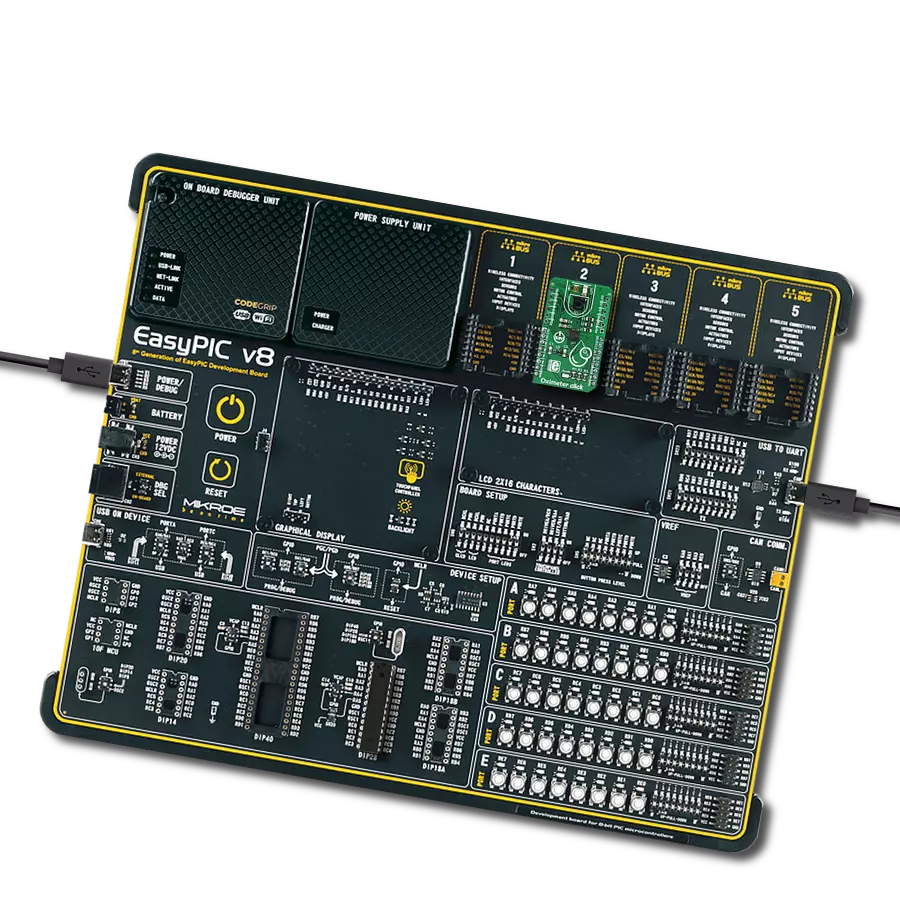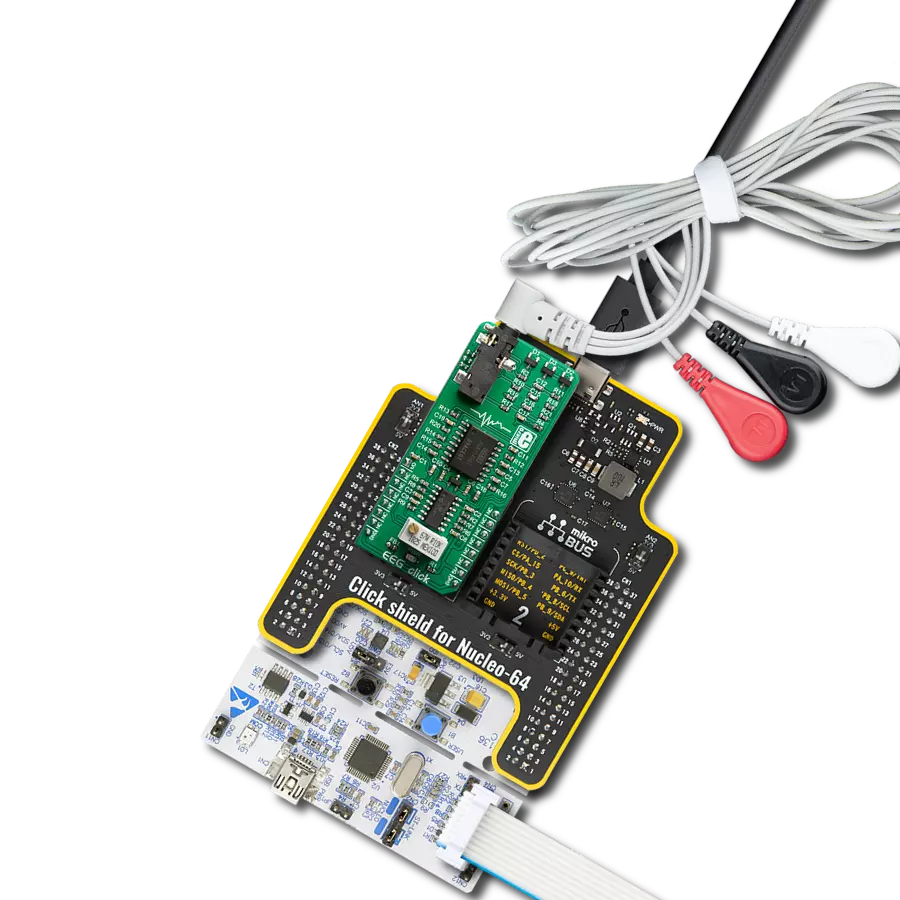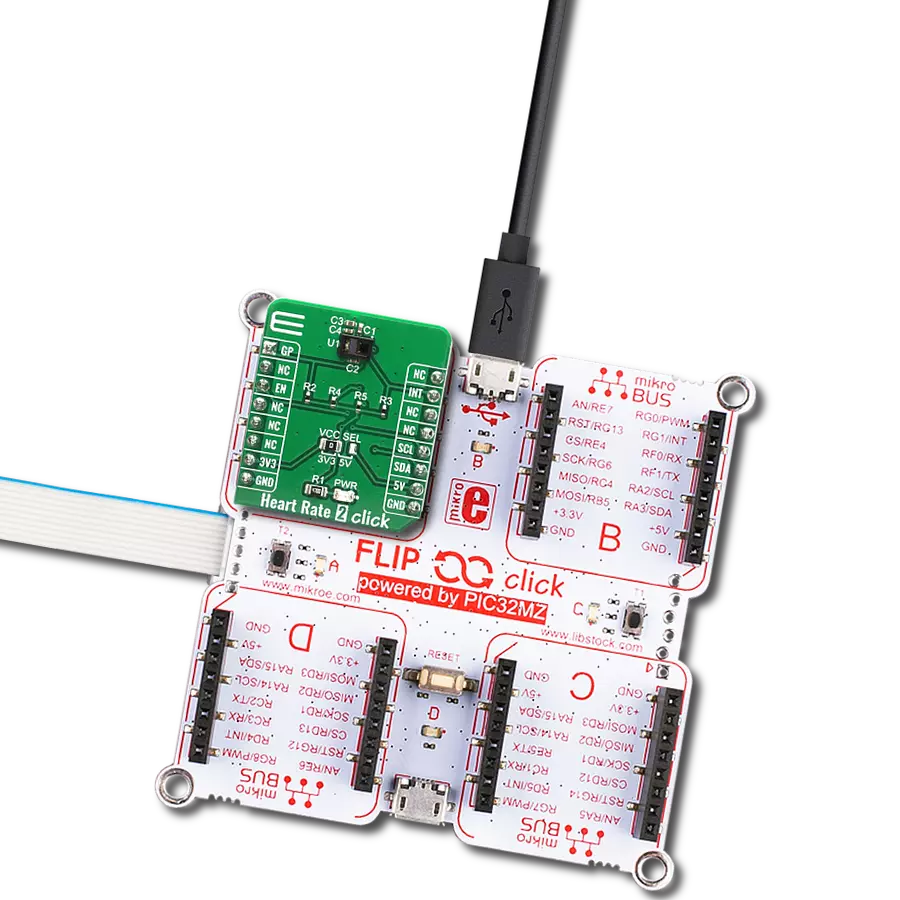Step into the future of vital-sign tracking by combining PPG and ECG technology for precise pulse rate measurement and comprehensive bio potential analysis
A
A
Hardware Overview
How does it work?
ECG/GSR Click is based on the AS7030B, a vital sign sensor based on Photoplethysmography (PPG) and Electrocardiogram (ECG) operations from AMS-AG. These two popular methods are suitable for heart rate monitoring (HRM) and heart rate variability (HRV), which measure the pulse rate by sampling light modulated by blood vessels that expand and contract as blood pulses through them. The ECG is the reference for any measurement of the bio-potential generated by the heart. This vital sign sensor features a low-noise analog front end, a single device integrated optical solution, and a synchronous demodulator. It consists of two 527nm green LEDs and one 940nm IR LED. The built-in infrared emitter and dedicated photodiode enable easy integration of the proximity function. Besides the HRM and SpO2, the AS7030B
is also anoptical measurement system for GSR (galvanic skin resistivity) and skin temperature obtained via an external temperature sensor connected to an onboard header labeled NTC. ECG/GSR Click communicates with MCU using the standard I2C 2-Wire interface that supports Standard-Mode (100 kHz) and Fast-Mode (400 kHz) operations. Also, it uses two additional pins, the INT pin of the mikroBUS™ socket, used as an interrupt, and the EN pin, routed on the CS pin of the mikroBUS™ socket, used to put the AS7030B into Normal operation mode or in a Shutdown. The AS7030B does not require a specific Power-Up sequence but requires a supply voltage of 3.8V to work correctly. Therefore, the Click board™ uses a low dropout linear regulator AP7331 from Diodes Incorporated, providing a 3.8V out of 5V mikroBUS™
rail.This Click board™ consists of two input channels routed to the 3.5mm jack connectors labeled as ECG and GSR, to which a 1m long ECG/EMG cable connects the electrodes to the appropriate Click board™ securely. The two electrode holders consist of a metal piece with a dent in the middle that perfectly fits the rivets on the electrodes. The contact with the measurement Click board™ remains good and secure while mounting the cable's electrodes is simple and easy. This Click board™ can operate with either 3.3V or 5V logic voltage levels selected via the VCC SEL jumper. This way, both 3.3V and 5V capable MCUs can use the communication lines properly. However, the Click board™ comes equipped with a library containing easy-to-use functions and an example code that can be used, as a reference, for further development.
Features overview
Development board
Nucleo-64 with STM32F091RC MCU offers a cost-effective and adaptable platform for developers to explore new ideas and prototype their designs. This board harnesses the versatility of the STM32 microcontroller, enabling users to select the optimal balance of performance and power consumption for their projects. It accommodates the STM32 microcontroller in the LQFP64 package and includes essential components such as a user LED, which doubles as an ARDUINO® signal, alongside user and reset push-buttons, and a 32.768kHz crystal oscillator for precise timing operations. Designed with expansion and flexibility in mind, the Nucleo-64 board features an ARDUINO® Uno V3 expansion connector and ST morpho extension pin
headers, granting complete access to the STM32's I/Os for comprehensive project integration. Power supply options are adaptable, supporting ST-LINK USB VBUS or external power sources, ensuring adaptability in various development environments. The board also has an on-board ST-LINK debugger/programmer with USB re-enumeration capability, simplifying the programming and debugging process. Moreover, the board is designed to simplify advanced development with its external SMPS for efficient Vcore logic supply, support for USB Device full speed or USB SNK/UFP full speed, and built-in cryptographic features, enhancing both the power efficiency and security of projects. Additional connectivity is
provided through dedicated connectors for external SMPS experimentation, a USB connector for the ST-LINK, and a MIPI® debug connector, expanding the possibilities for hardware interfacing and experimentation. Developers will find extensive support through comprehensive free software libraries and examples, courtesy of the STM32Cube MCU Package. This, combined with compatibility with a wide array of Integrated Development Environments (IDEs), including IAR Embedded Workbench®, MDK-ARM, and STM32CubeIDE, ensures a smooth and efficient development experience, allowing users to fully leverage the capabilities of the Nucleo-64 board in their projects.
Microcontroller Overview
MCU Card / MCU
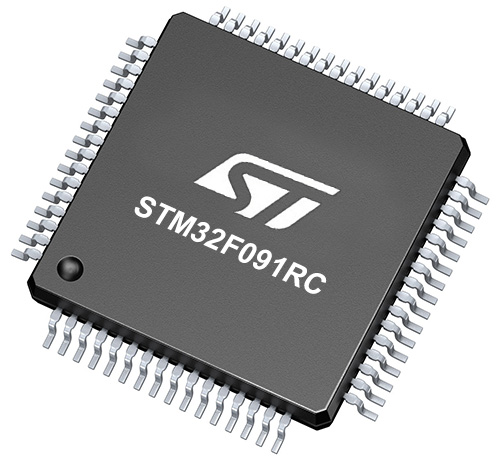
Architecture
ARM Cortex-M0
MCU Memory (KB)
256
Silicon Vendor
STMicroelectronics
Pin count
64
RAM (Bytes)
32768
You complete me!
Accessories
Click Shield for Nucleo-64 comes equipped with two proprietary mikroBUS™ sockets, allowing all the Click board™ devices to be interfaced with the STM32 Nucleo-64 board with no effort. This way, Mikroe allows its users to add any functionality from our ever-growing range of Click boards™, such as WiFi, GSM, GPS, Bluetooth, ZigBee, environmental sensors, LEDs, speech recognition, motor control, movement sensors, and many more. More than 1537 Click boards™, which can be stacked and integrated, are at your disposal. The STM32 Nucleo-64 boards are based on the microcontrollers in 64-pin packages, a 32-bit MCU with an ARM Cortex M4 processor operating at 84MHz, 512Kb Flash, and 96KB SRAM, divided into two regions where the top section represents the ST-Link/V2 debugger and programmer while the bottom section of the board is an actual development board. These boards are controlled and powered conveniently through a USB connection to program and efficiently debug the Nucleo-64 board out of the box, with an additional USB cable connected to the USB mini port on the board. Most of the STM32 microcontroller pins are brought to the IO pins on the left and right edge of the board, which are then connected to two existing mikroBUS™ sockets. This Click Shield also has several switches that perform functions such as selecting the logic levels of analog signals on mikroBUS™ sockets and selecting logic voltage levels of the mikroBUS™ sockets themselves. Besides, the user is offered the possibility of using any Click board™ with the help of existing bidirectional level-shifting voltage translators, regardless of whether the Click board™ operates at a 3.3V or 5V logic voltage level. Once you connect the STM32 Nucleo-64 board with our Click Shield for Nucleo-64, you can access hundreds of Click boards™, working with 3.3V or 5V logic voltage levels.
3-wire ECG/EMG cable comes with a convenient 3.5mm phone jack, and it is designed for electrocardiogram recording. This 1m cable is a practical companion for medical professionals and enthusiasts. To complement this cable, you can also use single-use adhesive ECG/EMG electrodes measuring 48x34mm, each equipped with an ECG/EMG cable stud adapter. These electrodes ensure a seamless experience when paired with our ECG/EMG cable and guarantee reliable ECG/EMG signal transmission for comprehensive cardiac monitoring. Trust in the accuracy and convenience of this setup to effortlessly record electrocardiograms and electromyograms with confidence.
Used MCU Pins
mikroBUS™ mapper
Take a closer look
Click board™ Schematic

Step by step
Project assembly
Software Support
Library Description
This library contains API for ECG/GSR Click driver.
Key functions:
void ecg_gsr_cfg_setup ( ecg_gsr_cfg_t *cfg );- Config Object Initialization function.ecg_gsr_err_t ecg_gsr_init ( ecg_gsr_t *ctx, ecg_gsr_cfg_t *cfg );- Initialization function.void ecg_gsr_default_cfg ( ecg_gsr_t *ctx );- Click Default Configuration function.
Open Source
Code example
The complete application code and a ready-to-use project are available through the NECTO Studio Package Manager for direct installation in the NECTO Studio. The application code can also be found on the MIKROE GitHub account.
/*!
* @file main.c
* @brief ECG GSR Click example.
*
* # Description
* This application collects data from the sensor, calculates it and then logs
* the result.
*
* The demo application is composed of two sections :
*
* ## Application Init
* Initializes driver, performs SW reset of all the registers, which puts
* the registers in their initial state.
*
* ## Application Task
* Depending on the user selection, application measures:
* 1. value of oxygen level in human's blood or
* 2. heartrate or
* 3. galvanic skin response
*
* \author MikroE Team
*/
#include "ecggsr.h"
#include "board.h"
#include "log.h"
// ------------------------------------------------------------------ VARIABLES
// ECG GSR context instance declaration.
static ecggsr_t ecggsr;
// ECG GSR configuration instance declaration.
ecggsr_cfg_t ecggsr_cfg;
// Logger context instance declaration.
static log_t logger;
// Device id slot.
static uint8_t dev_id = 0;
// Status of the ADC_DATA_L register.
static uint8_t adc_data_l_reg = 0;
// Status of the ADC_DATA_L register.
static uint8_t adc_data_h_reg = 0;
// Status of the low register of ADC.
static uint8_t adc_result_l = 0;
// Status of the high register of ADC.
static uint8_t adc_result_h = 0;
// ADC result.
static uint16_t adc_result = 0;
// ------------------------------------------------------ APPLICATION FUNCTIONS
void ecggsr_get_oxy_saturation( void )
{
// SEQ_START register. Start one ADC conversion.
ecggsr_write_reg( &ecggsr, ECGGSR_SEQ_START_REG, ECGGSR_START_ADC_CONVERSION );
Delay_1ms( );
ecggsr_write_reg( &ecggsr, ECGGSR_SEQ_START_REG, ECGGSR_START_ADC_CONVERSION );
Delay_5ms( );
// Read lower 8 bits of raw ADC data.
ecggsr_read_reg( &ecggsr, ECGGSR_ADC_DATA_L_REG, &adc_data_l_reg, 1 );
adc_result_l = adc_data_l_reg - ECGGSR_PPG_SCALE_VAL;
// Read higher 8 bits of raw ADC data.
ecggsr_read_reg( &ecggsr, ECGGSR_ADC_DATA_H_REG, &adc_data_h_reg, 1 );
adc_result_h = adc_data_h_reg & ECGGSR_ADC_DATA_H_MASK;
// Raw ADC result.
adc_result = ( ( uint16_t ) adc_result_h << 8 ) | adc_result_l;
if ( adc_result < ECGGSR_PPG_H_THRESHOLD )
{
adc_result = ECGGSR_PPG_H_THRESHOLD;
}
if ( adc_result_l > ECGGSR_PPG_MAX_VAL )
{
adc_result = ECGGSR_PPG_MAX_VAL;
}
// Final Oximeter results.
log_printf( &logger, "Level of oxygen saturation in your blood: %u\r\n", adc_result );
Delay_1sec ( );
}
void ecggsr_get_heartrate( void )
{
// SEQ_START register. Start one ADC conversion.
ecggsr_write_reg( &ecggsr, ECGGSR_SEQ_START_REG, ECGGSR_START_ADC_CONVERSION );
Delay_1ms( );
ecggsr_write_reg( &ecggsr, ECGGSR_SEQ_START_REG, ECGGSR_START_ADC_CONVERSION );
Delay_5ms( );
// Read lower 8 bits of raw ADC data.
ecggsr_read_reg( &ecggsr, ECGGSR_ADC_DATA_L_REG, &adc_data_l_reg, 1 );
adc_result_l = adc_data_l_reg;
// Read higher 8 bits of raw ADC data.
ecggsr_read_reg( &ecggsr, ECGGSR_ADC_DATA_H_REG, &adc_data_h_reg, 1 );
adc_result_h = ( adc_data_h_reg & ECGGSR_ADC_DATA_H_MASK );
// Raw ADC result.
adc_result = ( ( uint16_t ) adc_result_h << 8 ) | adc_result_l;
// Final heartrate results.
log_printf( &logger, "%u\r\n", adc_result );
}
void ecggsr_get_gal_skin_resp( void )
{
// SEQ_START register. Start one ADC conversion.
ecggsr_write_reg( &ecggsr, ECGGSR_SEQ_START_REG, ECGGSR_START_ADC_CONVERSION );
Delay_1ms( );
// SEQ_START register. Start one ADC conversion.
ecggsr_write_reg( &ecggsr, ECGGSR_SEQ_START_REG, ECGGSR_START_ADC_CONVERSION );
Delay_5ms( );
// Read lower 8 bits of raw ADC data.
ecggsr_read_reg( &ecggsr, ECGGSR_ADC_DATA_L_REG, &adc_data_l_reg, 1 );
adc_result_l = adc_data_l_reg;
// Read higher 8 bits of raw ADC data.
ecggsr_read_reg( &ecggsr, ECGGSR_ADC_DATA_H_REG, &adc_data_h_reg, 1 );
adc_result_h = adc_data_h_reg & ECGGSR_ADC_DATA_H_MASK;
// Raw ADC result.
adc_result = ( ( uint16_t ) adc_result_h << 8 ) | adc_result_l;
// Final Galvanic Skin Response results.
log_printf( &logger, "%u\r\n", ( uint16_t ) adc_result );
}
void application_init ( void )
{
log_cfg_t log_cfg;
/**
* Logger initialization.
* Default baud rate: 115200
* Default log level: LOG_LEVEL_DEBUG
* @note If USB_UART_RX and USB_UART_TX
* are defined as HAL_PIN_NC, you will
* need to define them manually for log to work.
* See @b LOG_MAP_USB_UART macro definition for detailed explanation.
*/
LOG_MAP_USB_UART( log_cfg );
log_init( &logger, &log_cfg );
log_info( &logger, "---- Application Init ----" );
// Click initialization.
ecggsr_cfg_setup( &ecggsr_cfg );
ECGGSR_MAP_MIKROBUS( ecggsr_cfg, MIKROBUS_1 );
ecggsr_init( &ecggsr, &ecggsr_cfg );
Delay_1sec();
ecggsr_default_cfg( &ecggsr, &ecggsr_cfg );
Delay_1sec();
}
void application_task( void )
{
// ------------------------------------------------------------
// Check the presence of the ECG GSR Click by reading device ID.
// ------------------------------------------------------------
ecggsr_read_dev_id( &ecggsr, &dev_id );
if ( ECGGSR_DEV_ID == dev_id )
{
// ------------------------------------------------------------
// Enable desired functionality of the ECG GSR Click.
// ------------------------------------------------------------
if ( ENABLE_OXIMETER_FUNCTIONALITY == ecggsr_cfg.click_functionality )
{
ecggsr_get_oxy_saturation( );
}
else if ( ENABLE_HEARTRATE_FUNCTIONALITY == ecggsr_cfg.click_functionality )
{
ecggsr_get_heartrate( );
}
else if ( ENABLE_GALVANIC_SKIN_RESPONSE_FUNCTIONALITY == ecggsr_cfg.click_functionality )
{
ecggsr_get_gal_skin_resp( );
}
}
}
int main ( void )
{
/* Do not remove this line or clock might not be set correctly. */
#ifdef PREINIT_SUPPORTED
preinit();
#endif
application_init( );
for ( ; ; )
{
application_task( );
}
return 0;
}
Additional Support
Resources
Category:Biometrics
